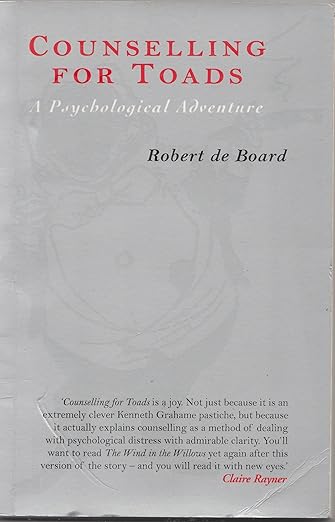“Councilling for Toads” by Robert de Board
Who is it for? for those looking to understand basic psychotherapeutic concepts
“Counselling for Toads: A Psychological Adventure” by Robert de Board is an imaginative and insightful book that introduces the principles of transactional analysis (TA) through a charming reinterpretation of the characters from Kenneth Grahame’s classic, “The Wind in the Willows.” The story focuses on Toad, who is experiencing depression. His friends, concerned about his well-being, encourage him to seek counselling.
In this novel, de Board cleverly uses the familiar characters of Toad, Ratty, Mole, and Badger to explore complex psychological concepts. The narrative follows Toad’s journey through counselling, where he learns to understand himself and his relationships with others. The book provides an accessible introduction to TA, covering topics such as ego states, script theory, and games theory, all within the context of Toad’s therapy sessions and interactions with his friends.
One of the key challenges for readers is the dual nature of the book. While it serves as a gentle introduction to TA, it is also a story about a beloved character facing mental health struggles. Readers seeking a straightforward self-help guide may find the storybook format unconventional. Conversely, those familiar with “The Wind in the Willows” might need to adjust to seeing these cherished characters in a more complex, psychological light.
Another challenge is applying the concepts of TA to one’s life based on the experiences of Toad. While the book does an excellent job of illustrating these principles in action, translating them from the fictional world of the Riverbank into practical, real-life applications can require further study and self-reflection.
In summary, “Counselling for Toads” is both a delightful revisit to a classic tale and a valuable educational tool for understanding basic psychotherapeutic concepts. De Board’s novel approach to explaining TA makes psychology accessible and engaging. However, the challenge for readers lies in extracting and applying these psychological insights to their understanding of themselves and their relationships in the real world. For those willing to embark on this unique psychological adventure, the book offers both enlightenment and enjoyment.

